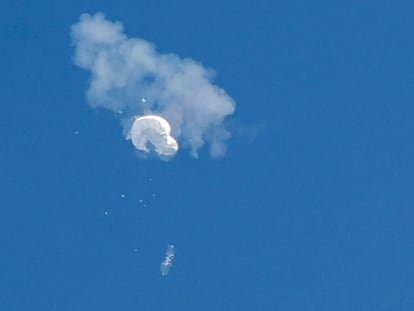China says more than 10 US balloons flew in its airspace
The Chinese allegation comes after America shot down a suspected spy balloon that had crossed from Alaska to South Carolina, sparking a new crisis in bilateral relations

China on Monday said more than 10 US high-altitude balloons have flown in its airspace during the past year without its permission, following Washington’s accusation that Beijing operates a fleet of surveillance balloons around the world.
The Chinese allegation comes after the US shot down a suspected Chinese spy balloon that had crossed from Alaska to South Carolina, sparking a new crisis in bilateral relations that have spiraled to their lowest level in decades.
Foreign Ministry spokesperson Wang Wenbin gave no details about the alleged US balloons, how they had been dealt with or whether they had government or military links.
“It is also common for US balloons to illegally enter the airspace of other countries,” Wang said at a daily briefing. “Since last year, US high-altitude balloons have illegally flown over China’s airspace more than 10 times without the approval of Chinese authorities.”
Wang said the US should “first reflect on itself and change course, rather than smear and instigate a confrontation.”
China says the balloon shot down by the US was an unmanned airship made for meteorological research that had been blown off course. It has accused the US of overreacting by shooting it down and threatened to take unspecified action in response.
Following the incident, US Secretary of State Antony Blinken canceled a visit to Beijing that many had hoped would put the brakes on the sharp decline in relations over Taiwan, trade, human rights and threatening Chinese actions in the disputed South China Sea.
Also Monday, the Philippines accused a Chinese coast guard ship of targeting a Philippine coast guard vessel with a military-grade laser and temporarily blinding some of its crew in the South China Sea, calling it a “blatant” violation of Manila’s sovereign rights.
Wang said a Philippine coast guard vessel had trespassed into Chinese waters without permission on Feb. 6 and that Chinese coast guard vessels responded “professionally and with restraint.” China claims virtually all of the strategic waterway and has been steadily building up its maritime forces and island outposts.
“China and the Philippines are maintaining communication through diplomatic channels in this regard,” Wang said. China’s Defense Ministry did not immediately respond to a question about the incident.
Adding to tensions, a US fighter jet shot down an “unidentified object” over Lake Huron on Sunday on orders from President Joe Biden. It was the fourth such downing in eight days in an extraordinary chain of events over US airspace that Pentagon officials believe has no peacetime precedent.
The Chinese balloon shot down by the US was equipped to detect and collect intelligence signals as part of a huge, military-linked aerial surveillance program that targeted more than 40 countries, the Biden administration declared Thursday, citing imagery from American U-2 spy planes.
Part of the reason for the repeated shootdowns is a “heightened alert” following the alleged Chinese spy balloon, Gen. Glen VanHerck, head of NORAD and the US Northern Command, said in a briefing with reporters.
The United States has since placed economic restrictions on six Chinese entities it said are linked to Beijing’s aerospace programs as part of its response to the incident. The US House of Representatives also voted unanimously to condemn China for a “brazen violation” of US sovereignty and efforts to “deceive the international community through false claims about its intelligence collection campaigns.”
Wang, the Chinese spokesperson, repeated China’s dismissal of such claims, saying, “the frequent firing of advanced missiles by the US to shoot down the objects is an overreaction of overexertion.”
Sign up for our weekly newsletter to get more English-language news coverage from EL PAÍS USA Edition
Tu suscripción se está usando en otro dispositivo
¿Quieres añadir otro usuario a tu suscripción?
Si continúas leyendo en este dispositivo, no se podrá leer en el otro.
FlechaTu suscripción se está usando en otro dispositivo y solo puedes acceder a EL PAÍS desde un dispositivo a la vez.
Si quieres compartir tu cuenta, cambia tu suscripción a la modalidad Premium, así podrás añadir otro usuario. Cada uno accederá con su propia cuenta de email, lo que os permitirá personalizar vuestra experiencia en EL PAÍS.
¿Tienes una suscripción de empresa? Accede aquí para contratar más cuentas.
En el caso de no saber quién está usando tu cuenta, te recomendamos cambiar tu contraseña aquí.
Si decides continuar compartiendo tu cuenta, este mensaje se mostrará en tu dispositivo y en el de la otra persona que está usando tu cuenta de forma indefinida, afectando a tu experiencia de lectura. Puedes consultar aquí los términos y condiciones de la suscripción digital.
More information
Archived In
Últimas noticias
Most viewed
- Reinhard Genzel, Nobel laureate in physics: ‘One-minute videos will never give you the truth’
- Oona Chaplin: ‘I told James Cameron that I was living in a treehouse and starting a permaculture project with a friend’
- Pablo Escobar’s hippos: A serious environmental problem, 40 years on
- Charles Dubouloz, mountaineering star, retires at 36 with a farewell tour inspired by Walter Bonatti
- Why we lost the habit of sleeping in two segments and how that changed our sense of time









































